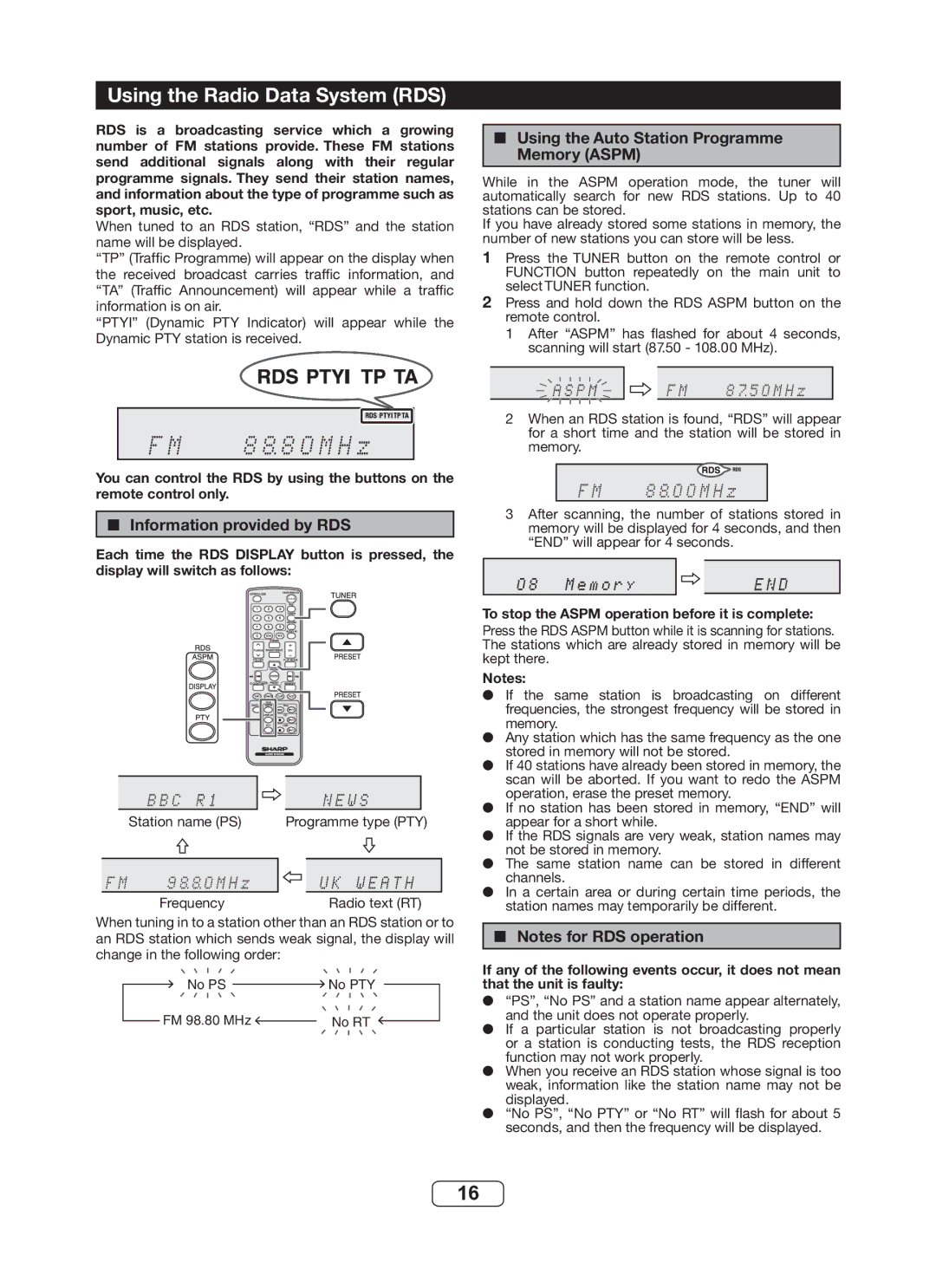
Using the Radio Data System (RDS)
RDS is a broadcasting service which a growing number of FM stations provide. These FM stations send additional signals along with their regular programme signals. They send their station names, and information about the type of programme such as sport, music, etc.
When tuned to an RDS station, “RDS” and the station name will be displayed.
“TP” (Traffic Programme) will appear on the display when the received broadcast carries traffic information, and “TA” (Traffic Announcement) will appear while a traffic information is on air.
“PTYI” (Dynamic PTY Indicator) will appear while the Dynamic PTY station is received.
You can control the RDS by using the buttons on the remote control only.
■Information provided by RDS
Each time the RDS DISPLAY button is pressed, the display will switch as follows:
|
|
|
|
|
|
|
|
|
|
|
|
|
|
|
|
|
|
|
| Station name (PS) | Programme type (PTY) | |||||
|
|
|
|
|
|
|
| |
|
|
|
|
|
|
|
|
|
|
| Frequency |
| Radio text (RT) | ||||
When tuning in to a station other than an RDS station or to an RDS station which sends weak signal, the display will change in the following order:
No PS | No PTY |
FM 98.80 MHz | No RT |
■Using the Auto Station Programme Memory (ASPM)
While in the ASPM operation mode, the tuner will automatically search for new RDS stations. Up to 40 stations can be stored.
If you have already stored some stations in memory, the number of new stations you can store will be less.
1� Press the TUNER button on the remote control or FUNCTION button repeatedly on the main unit to select TUNER function.
2� Press and hold down the RDS ASPM button on the remote control.
1� After “ASPM” has flashed for about 4 seconds, scanning will start (87.50 - 108.00 MHz).
2� When an RDS station is found, “RDS” will appear for a short time and the station will be stored in memory.
3� After scanning, the number of stations stored in memory will be displayed for 4 seconds, and then “END” will appear for 4 seconds.
To stop the ASPM operation before it is complete:
Press the RDS ASPM button while it is scanning for stations. The stations which are already stored in memory will be kept there.
Notes:
●If the same station is broadcasting on different frequencies, the strongest frequency will be stored in memory.
●Any station which has the same frequency as the one stored in memory will not be stored.
●If 40 stations have already been stored in memory, the scan will be aborted. If you want to redo the ASPM operation, erase the preset memory.
●If no station has been stored in memory, “END” will appear for a short while.
●If the RDS signals are very weak, station names may not be stored in memory.
●The same station name can be stored in different channels.
●In a certain area or during certain time periods, the station names may temporarily be different.
■Notes for RDS operation
If any of the following events occur, it does not mean that the unit is faulty:
●“PS”, “No PS” and a station name appear alternately, and the unit does not operate properly.
●If a particular station is not broadcasting properly or a station is conducting tests, the RDS reception function may not work properly.
●When you receive an RDS station whose signal is too weak, information like the station name may not be displayed.
●“No PS”, “No PTY” or “No RT” will flash for about 5 seconds, and then the frequency will be displayed.
16
